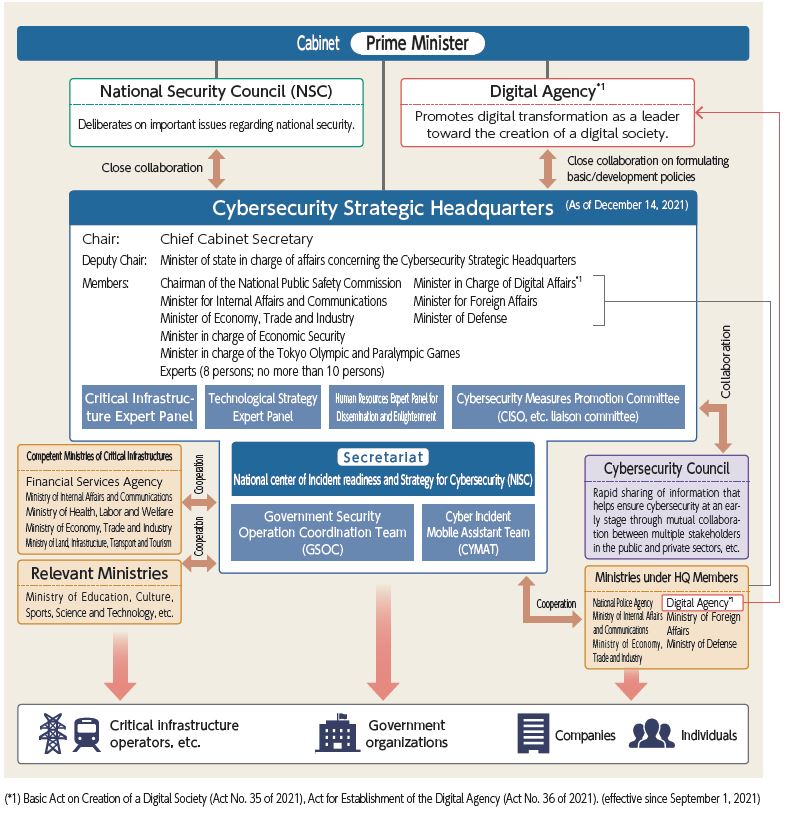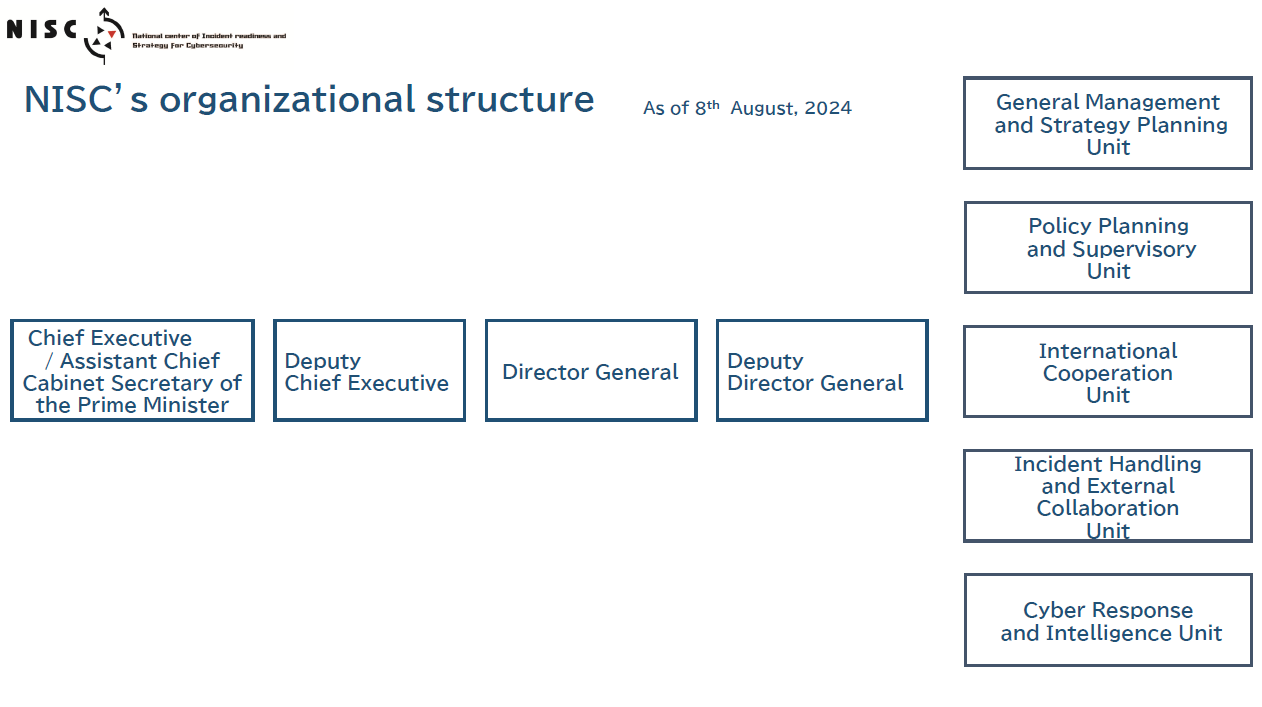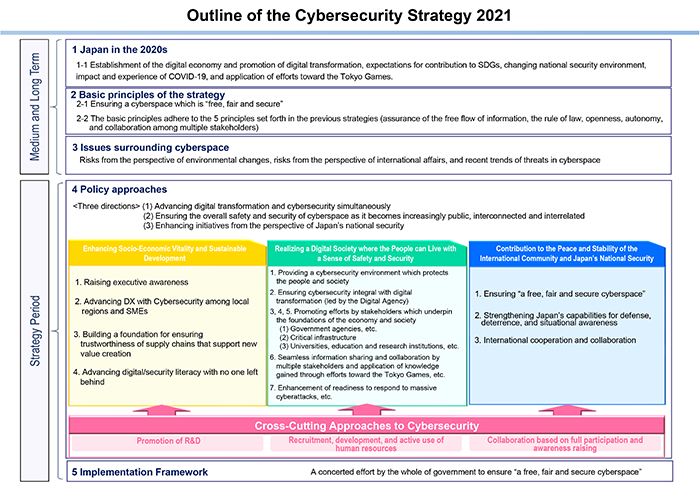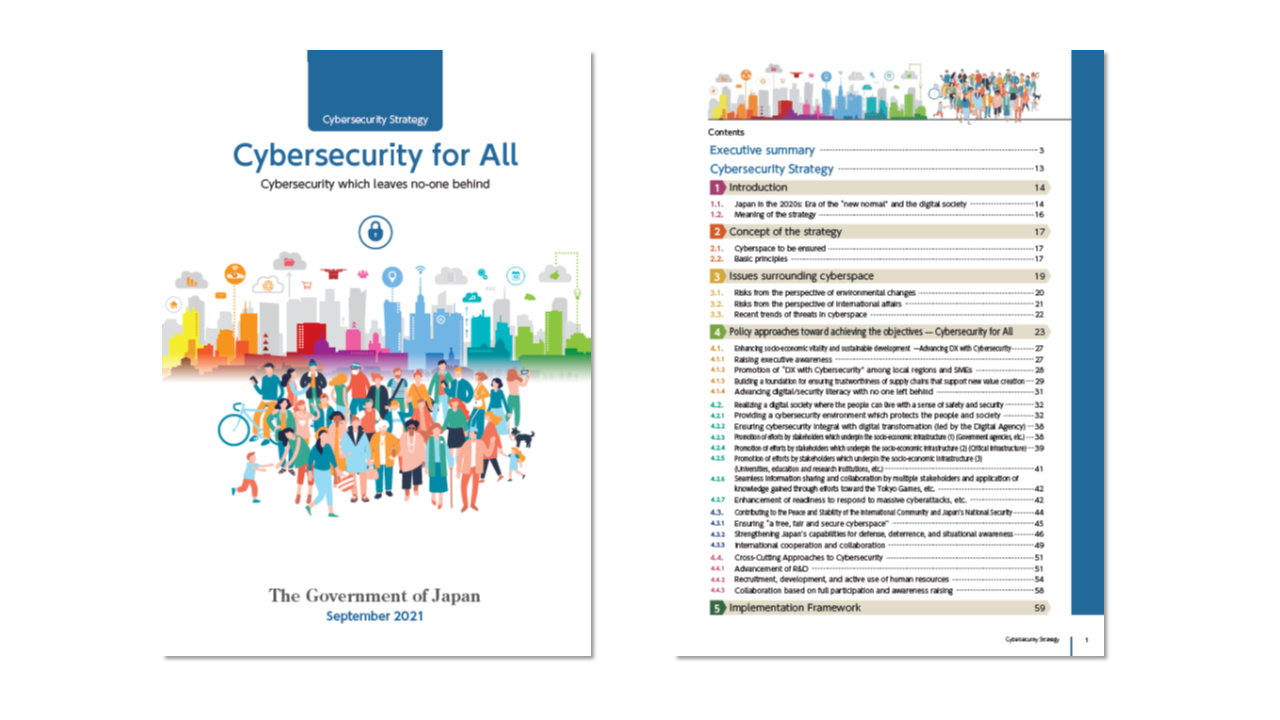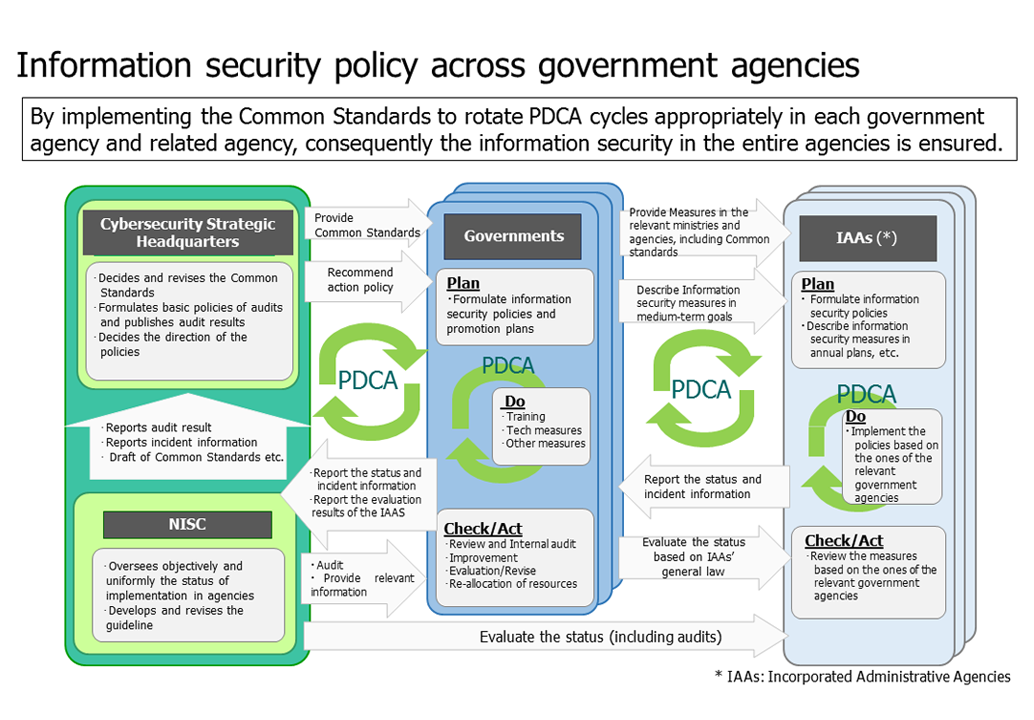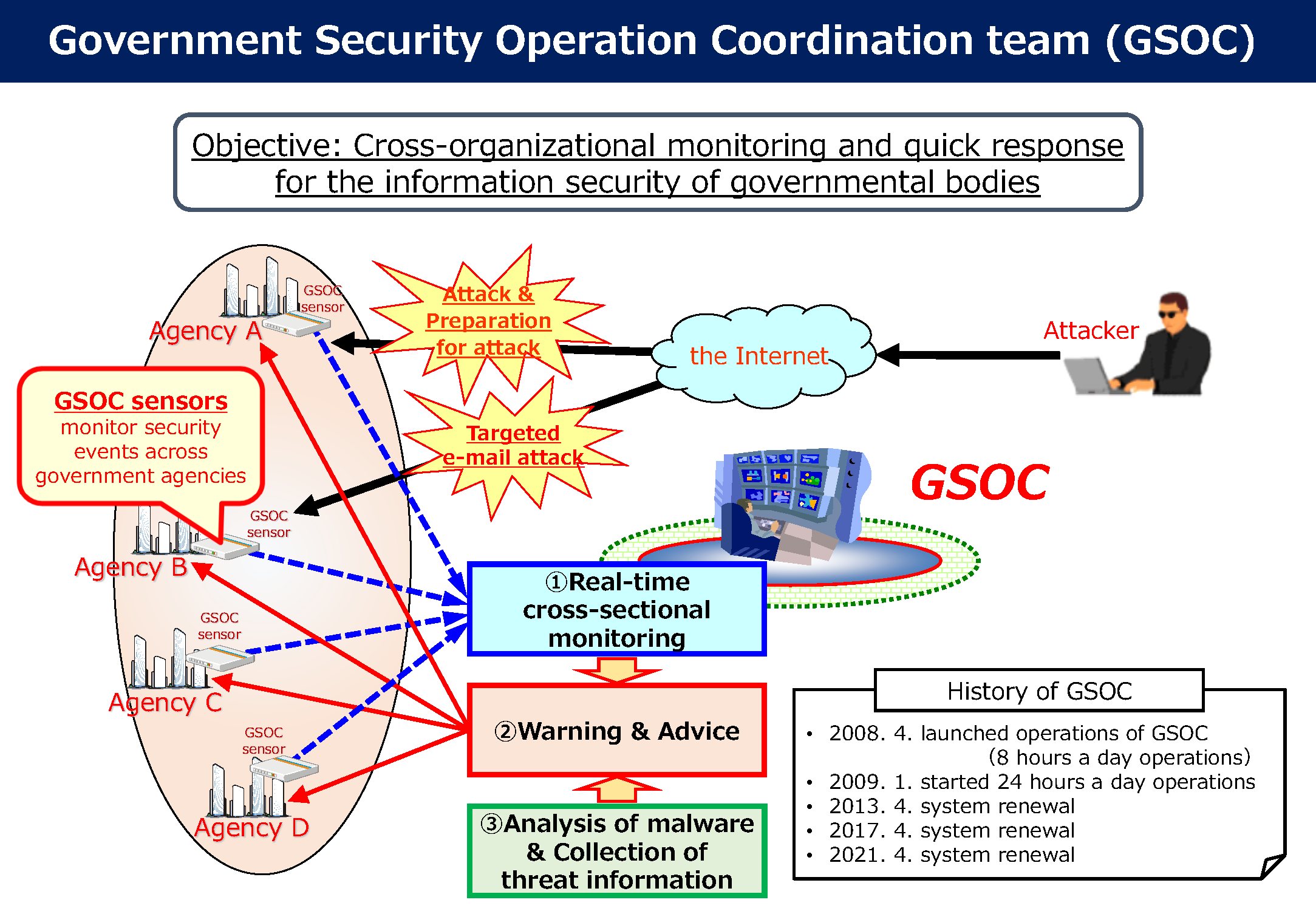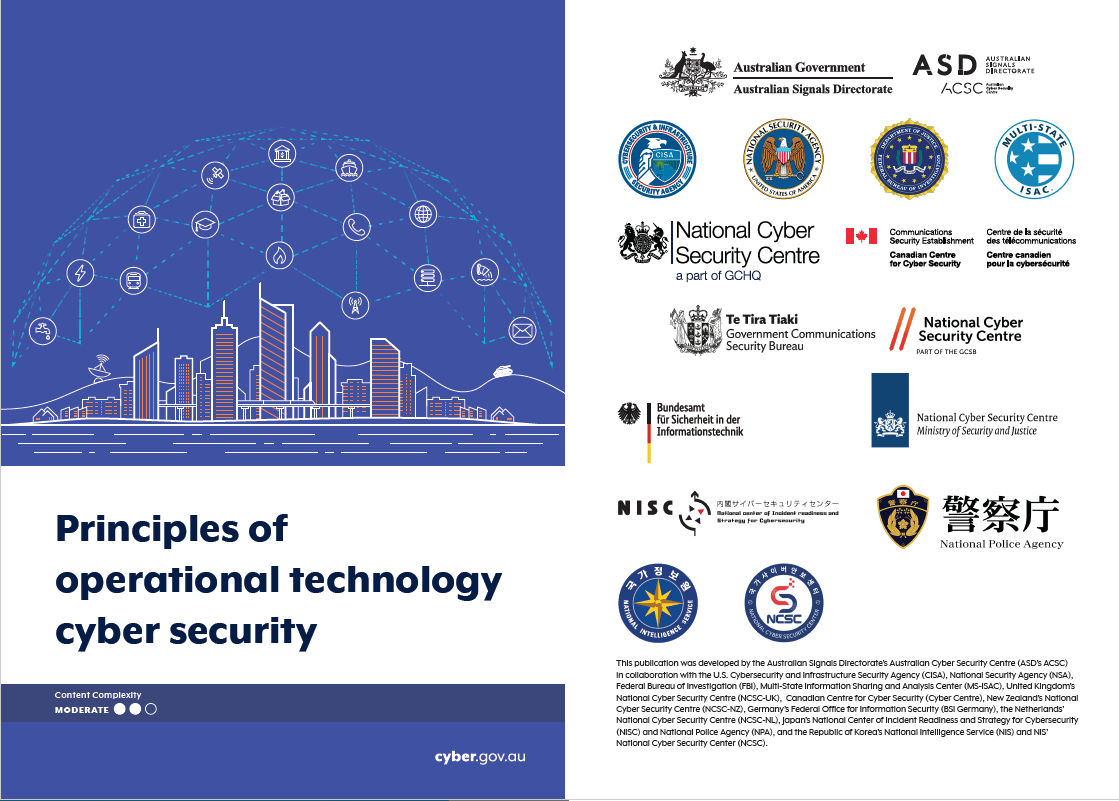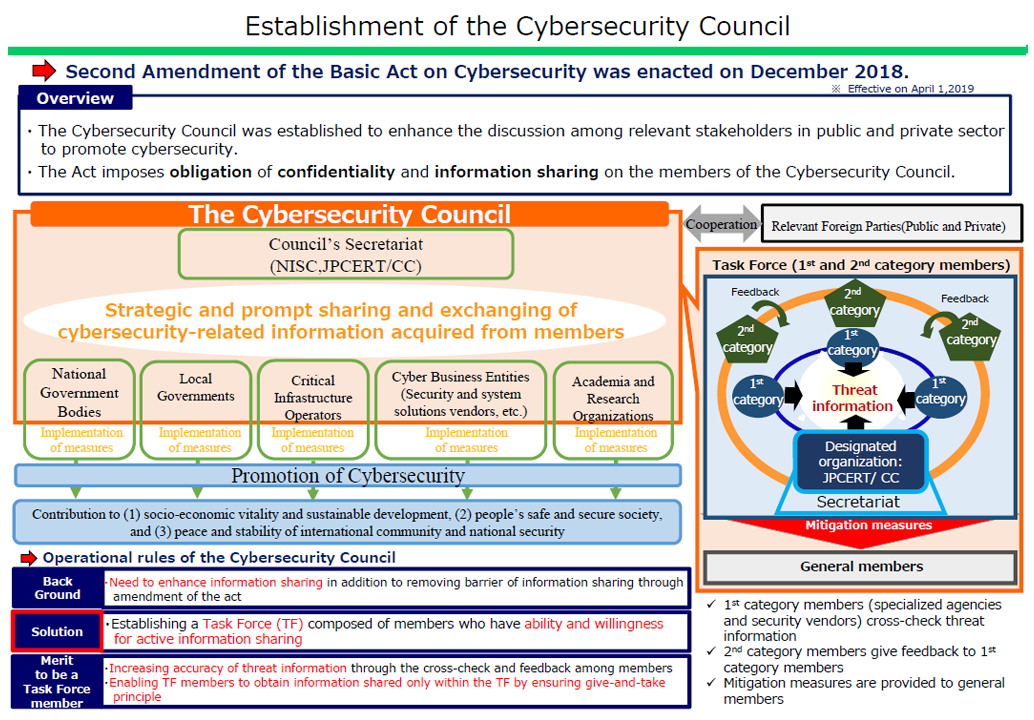Commitment to a Free,
Fair and Secure
Cyberspace.
What's new
-
Outcomes of the 18th ASEAN-Japan Cybersecurity Policy Meeting16 October 2025
-
Official Website for the ICC TOKYO 2025 Launched8 August 2025
-
Official Logo for the ICC TOKYO 2025 Unveiled6 June 2025
-
The date and venue for the ICC TOKYO 2025 have been set15 April 2025
-
NISC will jointly host the International Cybersecurity Challenge (ICC) for young promising talents in November 202518 March 2025
-
Alert: Cyberattacks by MirrorFace7 February 2025
-
Alert: Cyberattack by North Korean Cyber Actors, TraderTraitor7 February 2025
-
Outcomes of the 17th ASEAN-Japan Cybersecurity Policy Meeting8 November 2024
-
2024 Quad Cyber Challenge Joint Statement (October 21, 2024)23 October 2024
-
Japan's effort in 2024 Quad Cyber Challenge11 October 2024
-
NISC jointly sealed International Document "Principles of operational technology cyber security"2 October 2024
-
NISC jointly sealed International Guidance "Best practices for event logging and threat detection"22 August 2024
-
Overview of Cybersecurity 202410 July 2024
-
NISC jointly sealed International Advisory "APT40 Advisory PRC MSS tradecraft in action"9 July 2024
-
NISC jointly sealed International Guidance "Mitigating Cyber Threats with Limited Resources: Guidance for Civil Society"15 May 2024
-
The Cybersecurity Policy for CIP is revised to designate Ports and Harbours as a critical infrastructure sector8 March 2024
About NCO
The Cybersecurity Strategic Headquarters was established under the Cabinet in November, 2014 for
the purpose of effectively and comprehensively promoting cybersecurity policies. The Cybersecurity Strategic
Headquarters is headed by the Chief Cabinet Secretary, with his deputy - the Minister in charge of
Cybersecurity - and composed of the Chairman of the National Public Safety Commission, the other relevant
Ministers and knowledgeable experts from academia and business sectors.
National center of Incident readiness and Strategy for Cybersecurity, “NISC” has been established since 2015
which was formerly called National Information Security Center since 2005, under the same abbreviation “NISC”,
as a secretariat of the Cybersecurity Strategy Headquarters, working together with the public and private
sectors on a variety of activities to create a "free, fair and secure cyberspace".
NISC plays its leading role as a focal point in coordinating intra-government collaboration and promoting
partnerships between industry, academia, and public and private sectors.
NCO coordinates cybersecurity policy by formulating
- Cybersecurity Strategy
- Cybersecurity Policy for Critical Infrastructure Protection
- Common Standard on Information Security Measures of Government Entities
- Cybersecurity Human Resource Development Plan
- Cybersecurity Research and Development Strategy etc.
NCO takes a role of a governmental CERT, and NCO and JPCERT/CC, as a CERT covering private entities, work together as a national CERT.
NCO consists of the following seven groups. The main activities are as follows.
Strategy
Cybersecurity Strategy
The current Cybersecurity Strategy issued in September 2021 is the third one under the Basic Act on Cybersecurity. The Cybersecurity Strategy shows a basic position on cybersecurity policy, its objectives and its implementation for 3 years domestically and internationally. Overview of the Cybersecurity Strategy is as below.
The Basic Act on Cybersecurity
The Basic Act on Cybersecurity has been implemented since 2015 to promote the cybersecurity policy by
- setting basic principles of cybersecurity policy
- clarifying the responsibilities of the government, private entities, and citizens
- stipulating the framework for cybersecurity policy such as the cybersecurity strategy formulation and the establishment of the Cybersecurity Strategic Headquaters.
Government Network
Standard
NISC has set the Common Standards on Information Security Measures of Government Entities to raise the level of information security for all governmental agencies and related agencies, as the baseline standard. Based on the standard, NISC oversees the status of implementation of it across agencies by audits.
Operation
NISC operates real-time government-wide monitoring team called the Government Security Operation Coordination team (GSOC). GSOC not only monitors malicious communications incoming to or outgoing from government owned systems but also works as information sharing framework among governmental entities. GSOC provides alerts and advice for the governmental entities when they detect suspicious signals or malware.
Critical Infrastructure
Since 2005, the ‘Cybersecurity Policy for Critical Infrastructure Protection’ has been set as a
common action plan shared between
the government, which bears responsibility for promoting independent measures by CI operators relating to CI
cybersecurity and implementing other
necessary measures, and CI operators which independently carry out relevant protective measures, and the new
edition was published in 2022.
This document identifies the 14 sectors as critical infrastructure and it expects stakeholders to undertake
the five measures as below.
- Enhancement of Incident Response Capability
- Maintenance and Promotion of the Safety Principles
- Enhancement of Information Sharing System
- Utilization of Risk Management
- Enhancement of the Basis for CIP
- The Cybersecurity Policy for Critical Infrastructure Protection
- Full Text
- Abstract of The Cybersecurity Policy for Critical Infrastructure Protection
- Guideline for Establishing Safety Principles for Ensuring Cybersecurity of Critical Infrastructure(July 2023)
International Cooperation
As mentioned in the Cybersecurity Strategy of Japanese government, Japan strengthens
collaboration with its ally and like-minded countries as well as multi-layered frameworks that enable the
Japanese government to engage in practical international collaboration with their counterparts.
A part of the outcome of the activities in NISC as the national cybersecurity center is shown as below.
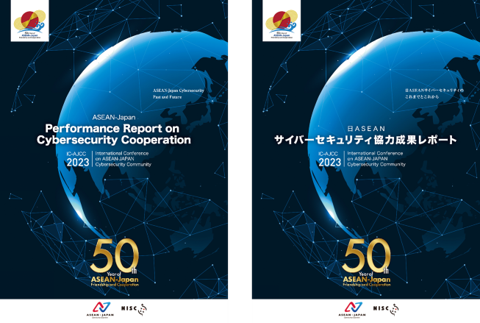
For further cybersecurity cooperation and capacity building in the ASEAN-Japan region, the activity result was summarized in the E-booklet.
LinkOther Projects
Quad Cyber Challenge
Japan, Australia, India, and the U.S. share fundamental values and are committed to
strengthening a free and open international order based on the rule of law. The four countries have been
promoting practical cooperation in various fields, including vaccines, infrastructure, climate change, and
critical and emerging technologies, to realize a "Free and Open Indo-Pacific (FOIP)". The four countries have
also concurred on the importance of making positive contribution to the region. (Reference: Japan-Australia-India-U.S.(Quad)
meetings )
Cooperation is also expected to be promoted in the field of cyber security, and the Japan-US-Australia-India
Summit Joint Statement(September 21, 2024) mentioned that throughout this fall, Quad countries each plan
to host campaigns to mark the annual Quad Cyber Challenge promoting responsible cyber ecosystems, public
resources, and cybersecurity awareness.
NISC invited three Japanese cybersecurity professionals on the front lines of their fields to deliver
special video messages highlighting the importance of cybersecurity jobs and the challenges they face. The
three experts also discussed their own experiences and their decision to choose a cybersecurity career path to
motivate students and young people to pursue this critical and challenging field.
※In Japanese alphabetical order
※Organizations and Job titles below are as of the time of the
interview
Security Analyst, The Security Solutions Business Division of the Security Cyber Resilience Headquarters Dept. of Hitachi Solutions, Ltd.
Security Engineer, The Professional Services Division of Flatt Security Inc.
Senior Executive Director, Director General of the Cybersecurity Research Institute at the National Institute of Information and Communications Technology (NICT)
Enhancement of Information Sharing
In order to enhance the information sharing among relevant stakeholders in public and private sector, with the amendment of the Basic Act on Cybersecurity, the Cybersecurity Council was newly established in April 2019, composed of national government bodies, critical infrastructure operators, security vendors, and other related organizations. The amended Act imposes the obligation of confidentiality on the members of the Council and so on to encourage the willingness of information sharing.
General Framework for Secure IoT Systems
NISC has set the ‘General Framework for Secure IoT Systems’ in 2016 which clarifies the fundamental and essential security requirements for secure IoT systems.
- General Framework for Secure IoT Systems
- General Framework for Secure IoT Systems
Archive
The Previous version of key documents such as Cybersecurity Strategy is shown in the link below.
